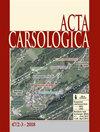斯洛文尼亚洞穴中岩溶水、地表和蝙蝠粪中的抗微生物大肠杆菌
IF 1.1
4区 地球科学
Q4 GEOSCIENCES, MULTIDISCIPLINARY
引用次数: 4
摘要
大肠杆菌是人类和吸热动物的主要肠道共生细菌之一,通常被认为是粪便污染的指标。从不同水文条件下的岩溶河流、旅游洞穴的步道和蝙蝠粪中分离到大肠杆菌菌株。分离株对氨苄青霉素、氯霉素、环丙沙星、萘啶酸、四环素和甲氧苄啶进行表型抗性测试。在岩溶水中发现的抗微生物大肠杆菌比例最高,其次是来自表面拭子和蝙蝠粪便的大肠杆菌。来自河流和拭子的几个分离株表现出多重耐药性表型。环境条件影响大肠杆菌种群;岩溶河流的溶解氧与大肠杆菌计数呈正相关,电导率与大肠杆菌浓度呈负相关。Malenščica(斯洛文尼亚)是一个拥有广泛集水区的饮用水资源,含有相对较高比例的抗微生物大肠杆菌菌株。蝙蝠粪中没有一个分离株对氨苄青霉素、氯霉素和四环素具有耐药性。未来对蝙蝠的监测应考虑定期跟踪新鲜鸟粪中的指示性微生物疾病指标。定期清洁洞穴内的旅游步道和洞穴入口处的消毒屏障,可显著降低大肠杆菌的浓度和传播。未来需要对其他大肠杆菌分离株的特征进行更详细的研究,以揭示它们的致病性、抗生素耐药性机制、可移动遗传元件以及向岩溶微生物组其他成员的基因转移频率。本文章由计算机程序翻译,如有差异,请以英文原文为准。
Antimicrobial resistant Escherichia coli from karst waters, surfaces and bat guano in Slovenian caves
Escherichia coli, one of the primary intestinal commensal bacteria in humans and endothermic animals, is commonly considered an indicator of faecal pollution. E. coli strains were isolated from karst rivers under different hydrological conditions, from footpaths in tourist caves and from bat guano. Isolates were tested for phenotypic resistance to ampicillin, chloramphenicol, ciprofloxacin, nalidixic acid, tetracycline and trimethoprim. The highest percentage of antimicrobial resistant E. coli was found in karst waters, followed by those from surface swabs and from bat guano. Several isolates from rivers and swabs exhibited multidrug-resistant phenotype. Environmental conditions impact the populations of E. coli; a positive correlation between dissolved oxygen and E. coli counts, and a negative correlation between conductivity and E. coli concentrations have been observed for karst rivers. Malenščica (Slovenia), a drinking water resource with an extensive catchment area, contained a relative high percentage of antimicrobial-resistant E. coli strains. None of the isolates from bat guano was resistant to ampicillin, chloramphenicol, and tetracycline. Future monitoring of bats should consider a regular follow-up of indicative microbial disease indicators in fresh guano. Regular cleansing of tourist footpaths in caves and disinfection barriers at the cave entrances reduce the concentration and transmission of E. coli significantly. A future, more detailed, study on characterization of additional E. coli isolates is needed to reveal their pathogeneicity, mechanisms of antibiotic resistance, mobile genetic elements, and gene transfer frequencies to other members of the karst microbiome.
求助全文
通过发布文献求助,成功后即可免费获取论文全文。
去求助
来源期刊

Acta Carsologica
地学-地球科学综合
CiteScore
1.50
自引率
14.30%
发文量
0
审稿时长
>12 weeks
期刊介绍:
Karst areas occupy 10-20 % of ice-free land. Dissolution of rock by natural waters has given rise to specific landscape and underground. Karst surface features and caves have attracted man''s curiosity since the dawn of humanity and have been a focus to scientific studies since more than half of millennia.
Acta Carsologica publishes original research papers and reviews, letters, essays and reports covering topics related to specific of karst areas. These comprise, but are not limited to karst geology, hydrology, and geomorphology, speleology, hydrogeology, biospeleology and history of karst science.
 求助内容:
求助内容: 应助结果提醒方式:
应助结果提醒方式:


